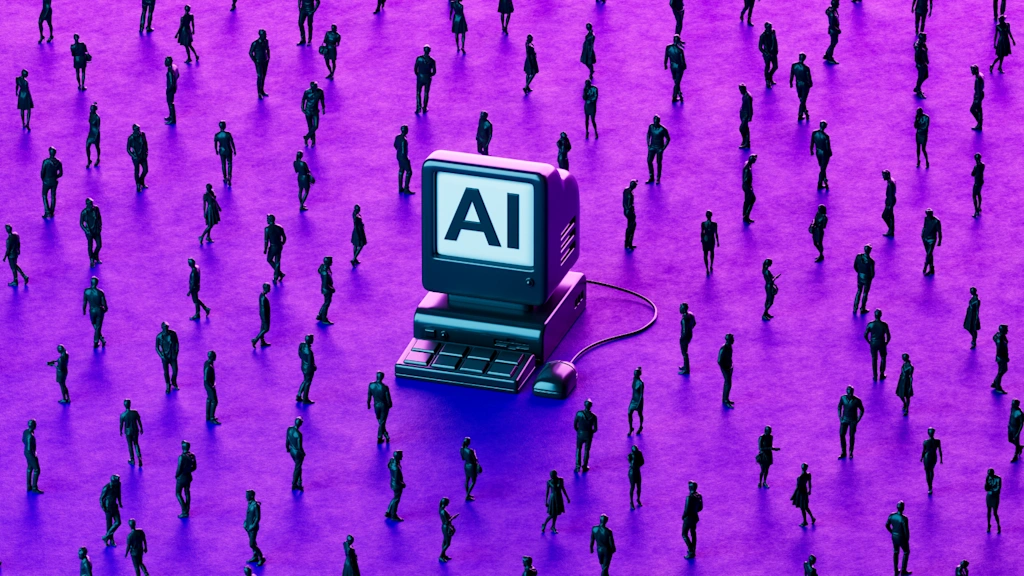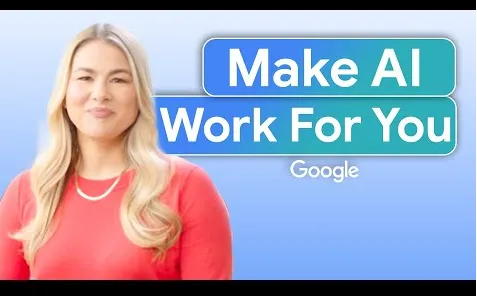#ai-adoption
#ai-adoption
[ follow ]
#generative-ai #productivity #ai-governance #agentic-ai #cybersecurity #organizational-transformation
Artificial intelligence
fromIndependent
6 days agoDear Vicki: 'My team is secretly using AI in the workplace. Should I stop them or encourage them?'
Encourage transparent, guided AI use with clear policies, training, attribution, and quality checks to balance innovation, integrity, and responsible team practices.
Artificial intelligence
fromFortune
1 day agoUsing AI at work can lead to a 'virtuous cycle,' with workers reporting better job satisfaction and efficiency, BCG chief AI ethics officer says | Fortune
Educating workers and applying rigorous risk reviews, bias evaluation, and acceptable-risk thresholds increases AI adoption, job satisfaction, and safer deployment.
fromMarTech
5 days agoGen Z leads surge in daily AI use, as B2B buying enters the generative era | MarTech
Eighty-six percent of Gen Z professionals now use AI daily at work, according to a new report by TrustRadius. It reveals a sharp uptick in AI adoption, a shift in how B2B professionals conduct product research and new content demands for marketers trying to remain visible in a generative AI-first environment. AI tools are no longer emerging technology - they're daily utilities.
Artificial intelligence
fromIT Pro
5 days agoUK software developers are still cautious about AI, and for good reason
Findings from the company's 2025 State of Developer Ecosystem report show 85% of developers globally regularly use AI for activities such as coding. Similarly, nearly two-thirds (62%) use at least one AI coding assistant, agent, or code editor in their daily workflow. Yet drilling down into regional and national perception of the technology, it appears many UK developers aren't fully sold. More than a quarter (27%), for example, said they're still "uncertain" about the use of AI.
Software development
fromBusiness Insider
5 days agoAmazon VP tells remaining workers to 'lean in on AI' in internal memo after massive layoffs
Moving forward, we remain focused on our mission to help product teams launch delightful products," Roy wrote in a memo posted by an employee to Amazon's internal Slack. "In support of this mission, I encourage you all to: Focus on the work that most directly impacts our customers, lean in on Al to enhance your effectiveness, [and] raise your hand when you see opportunities to simplify or eliminate unnecessary processes.
Gadgets
fromFortune
1 day agoWhy insurer Nationwide is investing $1.5 billion through 2028 on AI and other tech initiatives | Fortune
It is also indicative of a strategic pivot of Nationwide's AI Playbook. Four months ago, Fowler says the company's leadership met and wasn't pleased to see dozens of AI use cases had proliferated across the organization. While workers were getting more efficient, it wasn't always clear how they should use their extra time. Ten of Nationwide's C-suite leaders worked collaboratively to identify 18 flagship AI use cases to prioritize across the business.
Artificial intelligence
Higher education
fromInside Higher Ed | Higher Education News, Events and Jobs
1 day agoHigher Ed Tech Leaders Pursue Consolidation and Savings
Higher-education technology leaders are prioritizing cautious, ROI-driven investment in AI and cybersecurity while focusing on human, staffing, and interoperability challenges amid budget uncertainty.
Business
fromIT Pro
2 days agoHeavy workloads and botched digital initiatives are causing 'transformation fatigue' - and enterprises risk losing top talent if they don't change their ways
Failed or poorly executed digital transformation projects are causing burnout and transformation fatigue, risking the loss of top talent and increased employee turnover.
fromBusiness Insider
2 days agoAI is the fastest tech in history, but billions left out: Microsoft
Artificial intelligence is spreading faster than any technology in history - but billions of people are being left behind. That's the conclusion of Microsoft's new "AI Diffusion Report," which maps how AI use, infrastructure, and innovation are spreading globally. The company said that more than 1.2 billion people now use AI tools, a rate of adoption that it said has outpaced electricity, computers, and the internet. Yet this rapid diffusion is uneven.
Artificial intelligence
Artificial intelligence
fromHarvard Business Review
3 days agoTapping AI's Potential with Powerful Infrastructure from Cloud to Edge - SPONSOR CONTENT FROM ARM
AI expands economic possibilities by creating new markets, redefining industries, and enabling AI-native services, intelligent infrastructure, and hyper-personalized experiences.
fromComputerworld
2 days agoGartner: AI budgets are going to projects that demonstrate value, real-world impact
Many infrastructure and operations leaders aren't able to dig out enough money from budgets to reallocate to AI projects, Gartner said in a survey released this week. The research firm surveyed 253 IT leaders globally, and the budget issue plagued half the participants. As a result, 54% said they are focusing on AI projects with attainable results and foreseeable cost savings, Gartner said.
Artificial intelligence
fromwww.theguardian.com
2 days agoFootball Daily | Tactics derived from AI? The algorithms are watching'
From tracking player movement with eerie precision to whispering tactical tweaks into analysts' ears, artificial intelligence is now as common at training grounds as bibs and banter. Clubs crunch mountains of data to predict fatigue, refine pressing triggers, even scout teenagers before they've finished growing. VAR, of course, remains the clumsy cousin still learning when clear and obvious' actually means clear and obvious. But love it or loathe it, AI isn't leaving the pitch anytime soon.
Artificial intelligence
Information security
fromFortune
1 week agoI helped design rocket engines for NASA's space shuttles. Here's why businesses need AI as trustworthy as aerospace tech | Fortune
Trust and rigorous security processes must be built into AI deployments from day one to enable safe adoption and accelerate business growth.
Artificial intelligence
fromwww.businessinsider.com
1 week agoSome marketers are proudly touting anti-AI campaigns, but those promises could put them in a tricky spot down the road
Some major consumer brands publicly reject AI and promote human-authenticity even as corporate adoption and executive investment in AI continue and may become inevitable.
Artificial intelligence
fromTelecompetitor
1 week ago56% of Telecommunications Executives Use AI Agents: Report
56% of telecommunications executives use agentic AI; adoption covers security, support, customer service, product design, marketing, productivity, software, and network automation with measurable ROI.
Artificial intelligence
fromFortune
1 week agoExperts say the high failure rate in AI adoption isn't a bug, but a feature: 'Has anybody ever started to ride a bike on the first try?' | Fortune
High enterprise AI pilot failure rates reflect normal learning and experimentation rather than inherent flaws in the technology.
fromZDNET
1 week agoThese executives are really confused about AI
The growing use of AI in the workplace has been revealing one paradox after another. Use of the technology among individual workers is higher than ever, yet most businesses aren't reporting organization-wide gains; AI use in the customer service sector grows, but customers show they prefer speaking with humans; and businesses are racing to embed AI in their day-to-day operations, despite the fact that many of them don't trust the technology.
Artificial intelligence
fromIT Pro
1 week agoEmployee 'task crafting' could be the key to getting the most out of AI
Task crafting involves taking proactive steps to alter the scope, number, or type of tasks that make up an individual worker's role. Simply put, this involves using AI tools to reduce manual toil and free them up to focus on more important tasks. The more task crafting a worker carries out, the greater the link between AI adoption and efficiency gains at both the individual and organizational level.
Artificial intelligence
fromTheregister
1 week agoLloyds Bank claims Microsoft Copilot saves 46 minutes a day
We quickly identified the transformative impact that AI could deliver across our organisation, and over the last few years have put in place the assurance frameworks and tools we need to deploy AI safely and at scale. "With these foundations in place, we're reimagining how we operate by embedding AI across our business to drive smarter decisions, faster outcomes and better experiences.
Artificial intelligence
from24/7 Wall St.
1 week agoIs Starbucks' AI Push Proof We're in an AI Bubble?
Artificial intelligence (AI) is reshaping industries at an unprecedented pace, automating routine tasks, analyzing vast datasets, and enabling new forms of creativity that were once unimaginable. In workplaces, AI tools like chatbots and predictive analytics are streamlining workflows, allowing employees to focus on higher-value activities. Daily interactions have evolved too, with voice assistants handling everything from navigation to personalized recommendations, making life more efficient.
Artificial intelligence
fromMedium
2 weeks agoThe AI concept that changed our company's way of working
Since we started embracing the "production acceleration stage" in the company, we see product design with fresh perspectives. Fully immersed in AI dynamics Like almost all technology companies today, we are influenced and affected by AI at our core. Part of this technology adoption has brought new company challenges (ways of work, roles, technical knowledge, etc). Still, it has also led to many positive developments and ideas, allowing us to transform old problems into new opportunities.
UX design
Artificial intelligence
fromFortune
2 weeks agoHow Akamai's CIO balances enthusiasm and concerns about AI technology | Fortune
Akamai shifted from broad internal AI experimentation to a centralized, vendor-driven adoption model with measured deployments to manage overwhelming employee demand and boost productivity.
fromwww.housingwire.com
2 weeks agoAI in title and escrow is a 'force multiplier' not a 'job killer'
The study, which surveyed 631 industry professionals nearly double the number from Qualia's 2023 report found optimism about AI's benefits climbed 14% in just two years. Fifty-eight percent of respondents said they were optimistic or very optimistic about AI's potential, while 86% expressed at least a neutral stance. The structure of the real estate market is changing, said Qualia CEO Nate Baker. The title and escrow companies that adopt new technology to significantly reduce operational friction will have a huge advantage.
Real estate
fromSecuritymagazine
2 weeks agoFuture Proof Your Security Career with AI Skills
Various forms of artificial intelligence have been woven into our technology and work life since the 1960s, starting out in robotics and expanding into expert systems and early chatbots. This has, and will continue to evolve, in ways that make it imperative that security leaders have a solid understanding of how to use and integrate these readily available tools in their day-to-day operations and program deliverables.
Artificial intelligence
fromIT Pro
2 weeks agoThis new Microsoft tool lets enterprises track internal AI adoption rates - and even how rival companies are using the technology
"The cohort benchmark is based on a comparison cohort of employees within your company who share similar job functions, regions, or manager roles," the company noted. "The calculation uses Job function, Region, and Manager attributes to determine expected values by role. The cohort result looks at the role composition of the selected group, and constructs a weighted average expected result based on matching roles across the tenant."
Artificial intelligence
fromwww.housingwire.com
2 weeks agoRick Calle returns as loanDepot's chief strategy officer
Consumer Direct Lending is a key strategic advantage for loanDepot one of the few tech-powered, at-scale models of its kind with both best-in-class lead generation capabilities and top-tier customer recapture rates from our large servicing portfolio, Hsieh said in a statement.
Business
fromBusiness Matters
2 weeks agoMajor new UK-EU partnership to boost AI adoption and economic growth
The project, coordinated by the European High Performance Computing Joint Undertaking (EuroHPC JU), aims to help UK businesses and researchers take their first steps in using AI to improve productivity and unlock new economic potential. It will focus on raising digital literacy, providing technical expertise, and creating a pathway for companies to embed AI safely and efficiently within their operations.
Artificial intelligence
fromFortune
3 weeks agoI'm the Deloitte chair and I'm mindful of boardroom burnout: Here's how to optimize bandwidth for resilient, future-ready organizations | Fortune
Today's business landscape is evolving faster than ever. Shifting regulatory expectations, heightened demands for transparency, economic volatility, and intensifying global competition are all contributing to unprecedented complexity and pressure in the boardroom. Breakthroughs in technology-especially AI-are helping organizations and the people within them expand what they can achieve, but not without hurdles to overcome. With no playbook for this era, boards must rise to the challenge to navigate uncertainty and chart a path for the future in real time.
Business
fromTheregister
3 weeks agoStaff, schmaff: Business leaders racing to adopt unproven AI
BSI published a report this week that surveyed business leaders from eight countries around the world - including the UK and US - that found 39 percent of business leaders have already reduced junior and entry-level headcount in favor of more AI adoption. And it's not stopping there. The study found that a further 43 percent of business leaders expect to further reduce entry-level roles (which includes both cutting existing roles and not hiring new people) in the next year in favor of AI. A full 50 percent "specifically" said AI is helping them reduce headcount.
Artificial intelligence
fromFortune
3 weeks agoHow software maker Monday.com's 'AI Month' unlocked a gusher of employee-generated ideas | Fortune
And so earlier this year, Lereya kicked off "AI Month," a four-week initiative of dedicated programming that included 17 workshops, 22 speakers, and 71 working demos, the latter presented by the company's employees. The demos were all real tools that placed AI at the center of how work could be done to improve internal workflows or to make Monday.com's customer products even better.
Artificial intelligence
fromeLearning Industry
3 weeks agoDriving AI Adoption In L&D: What CEOs Need To Know Now
AI adoption is no longer optional in corporate learning; it is an investor and buyer expectation. For investors, Artificial Intelligence is a signal of scalability and long-term growth in a very fluctuating environment. On the other hand, for buyers, AI adoption is a sign of a modern, future-proof platform. Specifically, in the L&D industry, learners witness the potential of Machine Learning via personalization, adaptive AI workflows, and measurable results.
Online learning
Tech industry
fromFortune
3 weeks agoThese 2 kinds of employees are emerging in the AI-generated 'workslop' era-here's why it may be better to write the email yourself | Fortune
AI use divides workers into "pilots" who augment creativity and precision and "passengers" who produce low-value "workslop", reducing organizational ROI and increasing coworker burden.
[ Load more ]

















